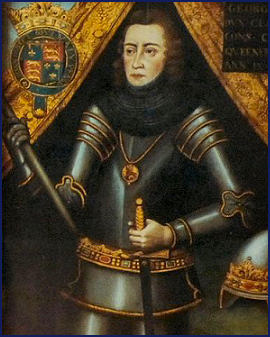This Day in History: February 18th
Today in History: February 18, 1478
 The antics of the feuding Plantagenet family wrangling for the English crown during the War of the Roses set the standard for all dysfunctional families to follow. Family loyalty meant very little to this bunch when it came to winning the throne of England.
The antics of the feuding Plantagenet family wrangling for the English crown during the War of the Roses set the standard for all dysfunctional families to follow. Family loyalty meant very little to this bunch when it came to winning the throne of England.
George Plantagenet, born in 1449 to the Duke of York and Cecily Neville, was no exception. He was the younger brother of King Edward IV, and the elder brother of Richard III (who allegedly had his two young nephews murdered because they were higher in the royal succession than he, but that’s a whole other heartwarming Plantagenet family story.)
When his father and second-oldest brother were slain at 1460 at Wakefield, the oldest son and heir Edward became King Edward VI. George moved up a rung to next-in-line to the throne, and was created Duke of Clarence.
But this wasn’t enough to satisfy the Duke. It started when George wanted to marry Isabel Neville, daughter of the Duke of Warwick. But his brother the King forbade it, no doubt intending to use his brother’s future marriage as an advantageous diplomatic tool, as was the norm for royalty in those days. Marrying for love was strictly for peasants.
The Duke of Clarence married Isabel anyway, and his new father-in-law encouraged him to rebel against his brother the King, promising to help Clarence claim England’s throne for himself. The plan failed, and the rebels had to high-tail it to France. Warwick joined forces with Margaret of Anjou, who just happened to be the wife of the deposed Lancastrian King Henry VI, currently being held prisoner in the Tower of London. They decided to invade England and restore Henry to the throne.
They were victorious, and King Henry was once again the King of England – for awhile. It also left the Duke of Clarence in a precarious position. In the interest of self-preservation, he thought it best to kiss up to Brother Edward, the King, and fought valiantly to restore him to the throne.
Peace was restored between the two siblings for a time, but inevitably trouble began brewing once again. After his wife Isabel died, Clarence wanted to marry the daughter of the late Duke of Burgundy, but the King put the kibosh on that. Things went from bad to worse, and the Duke of Clarence was charged with slandering the King and instigating a rebellion against him.
The Duke, aged 28, was privately executed on February 18, 1478. The story goes that he met his maker by being drowned in malmsey wine. Some say that this is just a catty reference to the Duke’s notorious drinking habit passed down through the ages. A little odd, since beheading was the usual mode of dispatching troublesome nobility in the Middle Ages. Remains that are believed to be the Duke’s exhumed from the Tower showed no sign of decapitation. Since the execution was private, there are no records of it. Some historians believe he may have been drowned in his bath.
When the Tudors took the English throne, the Duke of Clarence’s son, the Earl of Warwick, was executed by Henry VII on a trumped up charge of treason. His daughter, Margaret Pole, the Countess of Salisbury, was executed by Henry VIII at the age of 70 in one of the most gruesome and inhumane beheadings in English history. (She struggled mightily and due to the poor aim of the young executioner and her squirming, it took ten blows to separate her head from her body- more bludgeoning her to death than an execution via decapitation). Her execution was not really for any crime, but just because she had the bad luck to be a Plantagenet with an arguably better claim to the throne than this Welsh upstart Henry Tudor. Her son also went to the block for the same “crime.”
The Hatfields and the McCoys had nothing on the Yorks and the Lancasters.
If you liked this article, you might also enjoy our new popular podcast, The BrainFood Show (iTunes, Spotify, Google Play Music, Feed), as well as:
- The Wives of King Henry VIII
- King Richard the Lionheart of England Lived Mainly in France and Barely Spoke English
- The Modern King Leonidas: Athanasios Diakos
- The Bluetooth Standard is Named After a 10th Century Scandinavian King
| Share the Knowledge! |
|





“Margaret Pole[‘s] … execution was not really for any crime, but just because she had the bad luck to be a Plantagenet with an arguably better claim to the throne than this Welsh upstart Henry Tudor. Her son also went to the block for the same ‘crime.’”
The above is not fully correct. While Margaret Pole’s son, Henry, was executed on a false charge of treason, the elderly woman herself (referred to by the majority of Christians as “Blessed Margaret” since her beatification in 1886) was martyred — “in odium fidei” (in hatred of the Faith) — because of her religion.
Bl. Margaret, the Countess of Salisbury, had been the governess of Princess Mary (the daughter of Henry VIII and his only legitimate wife, Catharine of Aragon) — and was a devout Catholic who would not recognize the King as head of the Church in England. That was something that the royal “monster” would not tolerate in 1541.
One of Bl. Margaret’s other sons became Cardinal Reginald Pole, the last Catholic Archbishop of Canterbury. He was not executed, but later died within days of Queen Mary in 1558, having publicly spoken of his mother as a martyr for the Faith.